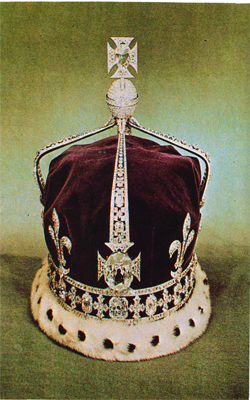 During the reign of the Qutb Shahi kings, Golconda became world famous as a trading place for diamonds, though diamonds were never mined in Golconda proper. Besides diamonds, the kingdom produced other precious stones like garnet, amethyst, topaz, agate etc. But pearls were imported from Persia. Golconda became famous for the cutting and polishing of diamonds.
In I645, a French jeweller by the name Tavernier visited Golconda and the Qutb Shahi k ingdom, and chronicled in detail what he saw of the diamond industry.
During the reign of the Qutb Shahi kings, Golconda became world famous as a trading place for diamonds, though diamonds were never mined in Golconda proper. Besides diamonds, the kingdom produced other precious stones like garnet, amethyst, topaz, agate etc. But pearls were imported from Persia. Golconda became famous for the cutting and polishing of diamonds.
In I645, a French jeweller by the name Tavernier visited Golconda and the Qutb Shahi k ingdom, and chronicled in detail what he saw of the diamond industry.
He tells us that diamonds were cut and polished in a village called “Karwan”near Golconda fort and that he saw 60,000 labourers at work in the Kollur group (on Krishna river) of mines which were part of the Golconda territory.
The Koh-i-noor as related by Tavernier was found in Kollur near the River Krishna in the year 1656 during the reign of Sultan Abdullah Qutb Shah. Mir Jumla who joined hands with the Mughals, presented the diamond, while still uncut, to Shah Jehan. The stone then weighed 787 carats. In 1665 the Koh-i-noor was seen by Tavernier in Aurangzeb’s treasury (Travels in India by Tavernier, page 343).
During the time of Mahmood Shah (1739) Nadir Shah took it to Iran.
After the death of Nadir Shah at Keleth in 1747, it was passed to his grandson Shah Rukh in Meshed. In 1751 Shah Rukh gave it as a reward to Ahmed Shah at Kabul, and later on it was passed by descent to his eldest son Shah Zaman, and then to Shah Zaman’s brother Sultan Shuja.
In 1812 the families of Zaman and Shuja went to Lahore and met Maharaja Ranjit Singh, the last ruler of the Punjab and in return for some favour it was presented to Maharaja Ranjit Singh. In 1839, Ranjit Singh died and at that time the Koh-i-noor was valued at one million sterling. Punjab was annexed in 1849 by the East India Company and the diamond was taken by Lord Lawrence and presented to Her Majesty, Queen Victoria.
The Koh-i-noor now weighed 106 carats and finally found its
place in the Imperial Regalia of Britain.
The PITT or REGENT diamond found in Paktial near Madras in 1701 originally weighed 410 carats. Later it was cut and reduced to 137 carats. It now lies in the Apollo Gallery of the Louvre, the French Museum.
The NIZAM diamond, 277 carats in weight, is said to be only a piece
of the mother diamond of 440 carats.
The GREAT TABLE diamond was also seen by Tavernier at Golconda. This 242-carat beauty was considered by Maskelyne to be exactly like the legendary DARYA-1-NUR or SEA OF LIGHT of the Persian Shahs.
The HOPE diamond is believed to be part of the BLUE diamond
shaped like a drop that was found and sold by Tavernier himself to the
French King Louis XIV in 1642. Its weight was 67 carats.
|
|